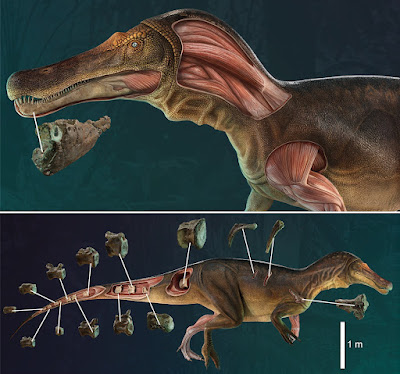 |
| Iberospinus natarioi Mateus & Estraviz-López, 2022 Paleoart by Victor Feijó de Carvalho. |
Abstract
Spinosaurids are some of the most enigmatic Mesozoic theropod dinosaurs due to their unique adaptations to aquatic environments and their relative scarcity. Their taxonomy has proven to be especially problematic. Recent discoveries from Western Europe in general, specifically Iberia, provide some of the best specimens for the understanding of their phylogeny, leading to the description of the spinosaurid Vallibonavenatrix cani and the recognition of the Iberian dinosaur Camarillasaurus cirugedae as one of them. Portuguese associated spinosaurid remains (ML1190) from the Papo Seco Formation (early Barremian) were previously assigned to Baryonyx walkeri but new material recovered in 2020 along with new phylogenetic analyses suggests a different phylogenetic placement, making their revision necessary. Here we show that these remains are not attributable to Baryonyx walkeri, but to a new genus and species, Iberospinus natarioi, gen. et sp. nov. The new taxon is characterized by the presence of a single Meckelian foramen in the Meckelian sulcus, a straight profile of the ventral surface of the dentary and a distal thickening of the acromion process of the pubis between other characters. Iberospinus natarioi is recovered as a sister taxon of the clade formed by Baryonyx and Suchomimus, and outside Spinosaurinae when Vallibonaventrix cani is excluded from the analysis. The description of this taxon reinforces Iberia as a hotspot for spinosaur biodiversity, with several endemic taxa for the region. As expected for the clade, the dentary displays a highly vascularized neurovascular network. The morphometric analysis of parts of the skeleton (pedal phalanx and caudal vertebrae, among others) shows an intermediate condition between basal tetanurans and spinosaurines.
 |
| Skeletal diagram showing in red the recovered elements of ML1190 (Iberospinus natarioi) at Praia de Aguncheiras. Courtesy of Scott Hartman. |
Dinosauria Owen, 1842
Theropoda Marsh, 1881
Megalosauroidea (Fitzinger, 1843)
Spinosauridae Stromer, 1915
Iberospinus n. gen.
Etymology: Ibero- derived from the Roman name for the Iberian Peninsula; and -spinus, latin for “spine”, because the length of the neural spines is one of the main features that defined the clade to which this animal belongs to.
Iberospinus natarioi sp. nov.
Etymology: Dedicated to Carlos Natário, who discovered the holotype.
Holotype: ML 1190, many bones from same individual (Table 1).Type locality and horizon: Praia de Aguncheiras (Also known as Praia do Guincho), in the municipality of Sesimbra, Setúbal district, Portugal (38.4° N, 9.2° W; paleocoordinates: 31.8° N, 1.3° E). The sediments that contain the fossil belong to the Papo Seco Formation, dated to Early Barremian.
Diagnosis: Medium sized spinosaurid theropod with the following autapomorphies: 1) dentary with a single foramen in the Meckelian sulcus, 2) dentary´s ventral edge is straight (not upturned), 3) presence of laminae in the pleurocelic depression of the medio-distal caudal vertebrae, 4) scapula, anterior rim is straight (acromion not protruding), 5) scapula with reduced acromial ridge, 6) scapula, contact with coracoid occupies the entire ventral surface, 7) pubic apron thick in almost the entire length of the pubis shaft, 8) mound like eminence in the proximal lateral part of the pubis.
Conclusions:
The revision of Barremian spinosaurid material previously assigned to Baryonyx along with newly recovered material from the site has led to the description of a new genus and species of Iberian spinosaurid, Iberospinus natarioi, from the Papo Seco Formation of Cabo Espichel, Sesimbra, Portugal. The specimen includes: dentary, isolated teeth, scapula, ribs, a dorsal vertebra, neural arches, pubic shaft, 15 caudal vertebrae, calcanea, and one pedal ungual (Fig 32). It is a medium sized spinosaurid diagnosable by: the dentary with only one foramen in the Meckelian sulcus and a straight ventral edge (not upturned), the presence of laminae in the pleurocelic depression of the medio-distal caudal vertebrae, the straight anterior rim of the scapula (acromion not protruding); the reduced acromial ridge of the scapula and the contact with coracoid occupying the entire ventral surface of it; the pubic apron being thick in almost the entire length of the pubis shaft, and the presence of a mound-like eminence in the proximal lateral part of the pubis. Phylogenetic analysis recovers Iberospinus natarioi outside of the clade formed by Suchomimus and Baryonyx, although other characters (like the teeth denticles) point towards an affinity with baryonychines. The morphometric analysis of several anatomical elements points towards an ecology similar to the expected for a basally branching spinosaurid. The addition of yet another taxon to the diversity of spinosaurids in Iberia besides Vallibonavenatrix, Baryonyx, and Camarillasaurus indicates that the clade possibly originated in Western Europe.
Octávio Mateus and Darío Estraviz-López. 2022. A New Theropod Dinosaur from the early Cretaceous (Barremian) of Cabo Espichel, Portugal: Implications for Spinosaurid Evolution. PLoS ONE. 17(2): e0262614. DOI: 10.1371/journal.pone.0262614



